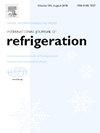采用改进的相变温度法制备了用于低温储热的相变纳米乳
IF 3.5
2区 工程技术
Q1 ENGINEERING, MECHANICAL
International Journal of Refrigeration-revue Internationale Du Froid
Pub Date : 2025-06-17
DOI:10.1016/j.ijrefrig.2025.06.020
引用次数: 0
摘要
基于高浓度乙二醇(EG)溶液的相变纳米乳被开发用于低温热储能(TES)。为解决高EG浓度下纳米乳稳定性差的问题,提出了一种改进的相变温度法。通过对工艺参数和纳米乳配方的优化,获得了稳定性更好的纳米乳。综合稳定性试验证实其长期储存稳定性增强。超过300次的热循环测试表明,液滴尺寸稳定在150 nm左右,多分散性指数为0.02。值得注意的是,含有40 wt % EG的样品的熔化焓和冻结焓分别下降了2.7%和0.8%,表明其具有较高的热循环性能。此外,含有30%、40%和50% EG的纳米乳液的储能容量分别显著超过基础液的94.60%、93.89%和105.85%。这些结果强调了这些纳米乳液在低温TES系统中应用的巨大潜力。本文章由计算机程序翻译,如有差异,请以英文原文为准。
Phase change nanoemulsions developed by a modified phase inversion temperature method for low-temperature thermal energy storage
Phase change nanoemulsions based on high-concentration ethylene glycol (EG) solutions have been developed for low-temperature thermal energy storage (TES). To address the challenge of poor nanoemulsion stability at high EG concentrations, a modified phase inversion temperature method was proposed. Through optimization of processing parameters and nanoemulsion formulation, nanoemulsions with improved stability were successfully achieved. Comprehensive stability tests confirmed their enhanced long-term storage stability. Thermal cycling tests performed over 300 cycles demonstrated that droplet sizes stabilized around 150 nm, with a polydispersity index <0.02. Notably, the sample containing 40 wt % EG demonstrated minor decreases in melting and freezing enthalpies of 2.7 % and 0.8 %, respectively, indicating its high thermal cycling performance. Furthermore, the energy storage capacities of nanoemulsions with 30, 40, and 50 wt % EG significantly exceeded those of the base fluids by 94.60 %, 93.89 %, and 105.85 %, respectively. These results underscore the significant potential of these nanoemulsions for application in low-temperature TES systems.
求助全文
通过发布文献求助,成功后即可免费获取论文全文。
去求助
来源期刊
CiteScore
7.30
自引率
12.80%
发文量
363
审稿时长
3.7 months
期刊介绍:
The International Journal of Refrigeration is published for the International Institute of Refrigeration (IIR) by Elsevier. It is essential reading for all those wishing to keep abreast of research and industrial news in refrigeration, air conditioning and associated fields. This is particularly important in these times of rapid introduction of alternative refrigerants and the emergence of new technology. The journal has published special issues on alternative refrigerants and novel topics in the field of boiling, condensation, heat pumps, food refrigeration, carbon dioxide, ammonia, hydrocarbons, magnetic refrigeration at room temperature, sorptive cooling, phase change materials and slurries, ejector technology, compressors, and solar cooling.
As well as original research papers the International Journal of Refrigeration also includes review articles, papers presented at IIR conferences, short reports and letters describing preliminary results and experimental details, and letters to the Editor on recent areas of discussion and controversy. Other features include forthcoming events, conference reports and book reviews.
Papers are published in either English or French with the IIR news section in both languages.

 求助内容:
求助内容: 应助结果提醒方式:
应助结果提醒方式:


